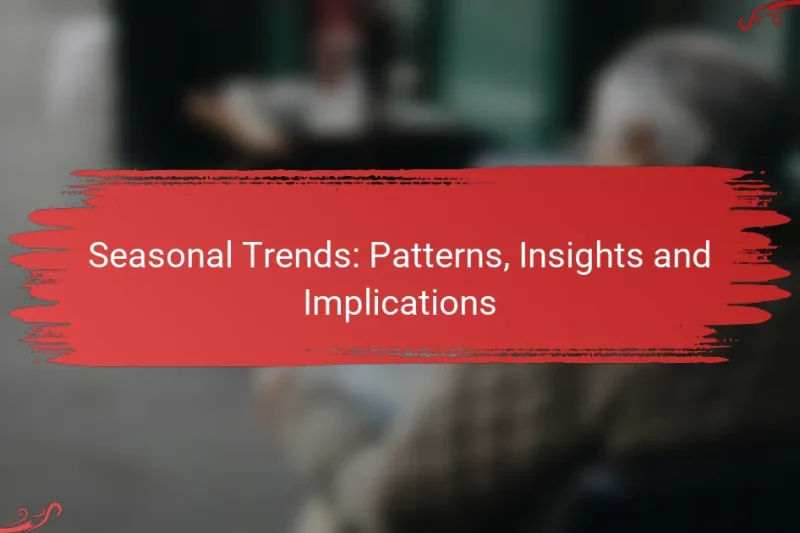Data visualization tools play a crucial role in helping businesses interpret complex data sets and make … Data Visualization Tools: Applications, Benefits and TechniquesRead more
Analyzing Media Trends
Analyzing media trends is essential for businesses aiming to enhance their advertising strategies in today’s dynamic landscape. By understanding current consumer behaviors and leveraging technology, companies can create impactful marketing campaigns that resonate with their target audience. Tools like Google Analytics, BuzzSumo, and Hootsuite provide valuable insights into audience engagement and content performance, enabling informed decision-making.
Predictive Analytics: Forecasting Techniques, Tools and Applications
Predictive analytics plays a crucial role in forecasting by utilizing various techniques such as regression analysis, … Predictive Analytics: Forecasting Techniques, Tools and ApplicationsRead more
Emerging Trends: Identification Methods, Tools and Insights
As we move into 2024, emerging identification methods are revolutionizing security and user experience through innovative … Emerging Trends: Identification Methods, Tools and InsightsRead more
Competitive Analysis: Strategies, Metrics and Benefits
Competitive analysis is essential for businesses looking to enhance their display advertising strategies by evaluating competitors’ … Competitive Analysis: Strategies, Metrics and BenefitsRead more
Successful Media Trend Analysis: Case Studies and Insights
Successful media trend analysis is crucial for optimizing display advertising by providing marketers with insights into … Successful Media Trend Analysis: Case Studies and InsightsRead more
Seasonal Trends: Patterns, Insights and Implications
Seasonal trends play a crucial role in shaping consumer behavior, leading to significant variations in spending … Seasonal Trends: Patterns, Insights and ImplicationsRead more
Cultural Shifts: Impact on Media Trends and Consumption
Cultural shifts in the United States are profoundly transforming media consumption trends, affecting how audiences interact … Cultural Shifts: Impact on Media Trends and ConsumptionRead more
What are the current media trends in advertising?
Current media trends in advertising focus on leveraging technology and consumer behavior to maximize engagement and effectiveness. Key trends include increased use of programmatic advertising, a rise in video content consumption, and growth in influencer marketing.
Increased use of programmatic advertising
Programmatic advertising automates the buying and selling of ad space, allowing for real-time bidding and more precise targeting. This approach can lead to higher efficiency and better ROI, as ads are shown to the right audience at the right time.
Advertisers should consider utilizing data analytics to optimize their programmatic strategies. By analyzing user behavior and preferences, brands can refine their targeting and improve ad performance. However, it’s crucial to monitor ad placements to avoid brand safety issues.
Rise of video content consumption
Video content consumption has surged, with many consumers preferring video over text or images. Platforms like YouTube, TikTok, and Instagram Reels have become essential for brands looking to engage audiences effectively.
To capitalize on this trend, advertisers should create short, engaging video content tailored to their target demographics. Consider using storytelling techniques and clear calls to action to enhance viewer engagement. Keep videos concise, ideally under two minutes, to maintain viewer interest.
Growth of influencer marketing
Influencer marketing continues to expand as brands collaborate with social media personalities to reach niche audiences. This trend leverages the trust and authenticity influencers have built with their followers, making it a powerful tool for brand promotion.
When engaging with influencers, brands should focus on authenticity and alignment with their values. Choosing influencers who genuinely connect with their products can lead to more effective campaigns. Additionally, tracking engagement metrics can help assess the success of influencer partnerships and guide future strategies.
How can businesses leverage media trends for advertising?
Businesses can leverage media trends for advertising by staying informed about current consumer behaviors and preferences. This allows them to create more effective marketing strategies that resonate with their target audience.
Utilizing data analytics for targeted campaigns
Data analytics enables businesses to gather insights about consumer behavior, preferences, and engagement patterns. By analyzing this data, companies can segment their audience and tailor their advertising campaigns to specific demographics, increasing the likelihood of conversion.
For example, a business might use analytics tools to identify which products are most popular among different age groups. This information can guide targeted promotions, ensuring that marketing messages reach the right people at the right time.
Adopting multi-channel marketing strategies
Multi-channel marketing involves using various platforms to reach consumers, such as social media, email, and traditional media. This approach allows businesses to maximize their visibility and engage with customers across different touchpoints.
For effective multi-channel marketing, companies should ensure consistent messaging and branding across all platforms. A common pitfall is neglecting to adapt content to fit the unique characteristics of each channel, which can dilute the overall impact of the campaign.
What tools are available for analyzing media trends?
Several tools can effectively analyze media trends, helping businesses and individuals understand audience engagement and content performance. Key options include Google Analytics, BuzzSumo, and Hootsuite, each offering unique insights tailored to different aspects of media analysis.
Google Analytics for tracking engagement
Google Analytics is a powerful tool for tracking user engagement on websites. It provides detailed metrics on visitor behavior, such as page views, session duration, and bounce rates, allowing you to gauge how well your content resonates with your audience.
To maximize its effectiveness, set up goals and conversion tracking to measure specific actions, like newsletter sign-ups or product purchases. Regularly review reports to identify trends and adjust your content strategy accordingly.
BuzzSumo for content analysis
BuzzSumo specializes in content analysis, enabling users to discover what types of content perform best across various platforms. It provides insights into social shares, backlinks, and engagement metrics, helping you identify popular topics and influencers in your niche.
Utilize BuzzSumo’s content alerts to stay updated on new articles related to your interests. This can inform your content creation and curation strategies, ensuring you remain relevant and competitive.
Hootsuite for social media insights
Hootsuite is a comprehensive social media management tool that offers valuable insights into social media performance. It allows you to track engagement metrics across multiple platforms, including likes, shares, and comments, providing a holistic view of your social media presence.
To effectively use Hootsuite, create custom reports that focus on key performance indicators relevant to your goals. Regularly analyze these reports to refine your social media strategy and improve audience engagement.
What are the key metrics for measuring media trend effectiveness?
Key metrics for measuring media trend effectiveness include click-through rates (CTR), return on ad spend (ROAS), and engagement rates. These metrics help assess how well media campaigns are performing and guide adjustments to optimize results.
Click-through rates (CTR)
Click-through rate (CTR) measures the percentage of users who click on a specific link compared to the total number of users who view an ad or content. A higher CTR indicates that the media is effectively capturing audience interest. Typical CTR benchmarks vary by industry but often range from 1% to 5%.
To improve CTR, focus on creating compelling headlines and clear calls to action. Avoid overly complex language and ensure your content is relevant to the target audience. Regularly testing different ad formats and placements can also yield better results.
Return on ad spend (ROAS)
Return on ad spend (ROAS) calculates the revenue generated for every dollar spent on advertising. A ROAS of 4:1 means that for every $1 spent, $4 is earned in revenue. Businesses typically aim for a ROAS of at least 3:1 to ensure profitability.
To maximize ROAS, analyze which channels and campaigns yield the highest returns. Adjust budgets accordingly and consider reallocating funds from underperforming ads to those with better performance. Tracking and optimizing campaigns in real-time can significantly enhance overall returns.
Engagement rates
Engagement rates measure how users interact with content, including likes, shares, comments, and time spent on a page. High engagement indicates that the content resonates with the audience, which can lead to increased brand loyalty and conversions. Engagement rates can vary widely, often falling between 1% and 10% depending on the platform and content type.
To boost engagement rates, create content that encourages interaction, such as polls, quizzes, or user-generated content. Monitor audience feedback and adapt your strategy to align with their preferences. Regularly updating content and maintaining a consistent posting schedule can also help keep the audience engaged.
What are the challenges in analyzing media trends?
Analyzing media trends involves several challenges, including data overload and rapidly changing consumer behavior. These factors can complicate the extraction of meaningful insights and the development of effective strategies.
Data overload and interpretation
Data overload occurs when analysts are inundated with vast amounts of information from various media sources, making it difficult to discern valuable insights. This can lead to analysis paralysis, where decision-makers struggle to act due to the sheer volume of data available.
To manage data overload, prioritize key metrics that align with specific goals. For instance, focus on engagement rates or conversion metrics rather than trying to analyze every data point. Tools that aggregate and visualize data can also help streamline interpretation.
Rapidly changing consumer behavior
Consumer behavior in media is constantly evolving, influenced by trends, technology, and cultural shifts. This rapid change can make it challenging to predict future trends or to develop long-term strategies that remain relevant.
To stay ahead, regularly conduct market research and monitor social media platforms for emerging trends. Engaging with consumers through surveys or feedback can provide real-time insights into their preferences. Additionally, being flexible and ready to adapt strategies based on consumer feedback is crucial for success.
How to stay updated with emerging media trends?
To stay updated with emerging media trends, regularly engage with reliable sources and communities that focus on industry developments. This includes following publications, attending events, and leveraging online platforms for real-time insights.
Following industry publications
Industry publications are essential for keeping abreast of media trends. Subscribe to leading magazines, blogs, and newsletters that focus on your specific area of interest, such as advertising, digital media, or journalism. Examples include Adweek, MediaPost, and The Drum.
Consider setting up alerts for key topics or trends to receive timely updates. Many publications offer a mix of free and premium content, so evaluate which subscriptions provide the most value for your needs.
Participating in webinars and conferences
Webinars and conferences provide opportunities to learn from experts and network with peers. Look for events that focus on emerging technologies, consumer behavior, and innovative media strategies. Many organizations host virtual events, making it easier to participate from anywhere.
When attending, prepare questions in advance and engage with speakers and other attendees. This interaction can lead to valuable connections and insights that may not be available through traditional publications.






